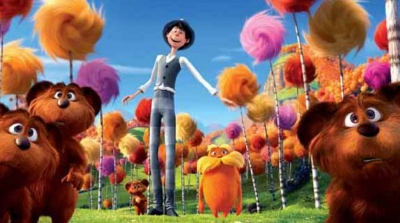
The mighty Lorax
The Lorax is a fictional character introduced by Dr. Seuss in the eponymous book published in 1971. The book is about the plight of the environment and the Lorax, who “speaks for the trees”. The Lorax confronts the Once-ler, a reckless Thneed entrepreneur whose unrestrained ambition leads to the destruction of the environment. The main conversation that takes place within the book is between the Once-ler and the Lorax. While the Lorax speaks in defence of the environment and the animals that inhabit it, the Once-ler sides with his business. The Lorax” is an exemplary tale primarily about a person’s responsibilities to the environment and represents the interests of all the creatures whose lives are affected negatively by the environmental degradation. The Lorax tries to convince the Once-ler to prevent destruction of the environment. However, the environment gets totally decimated before the Once-ler realises the harm he has caused. The story is also a hopeful account ending with the likelihood of environmental restoration when the Once-ler accepts responsibility.
Birdman of India
Sálim Moizuddin Abdul Ali was an Indian ornithologist and naturalist. He was popularly known as the “Birdman of India”. Ali wrote many articles mainly in “Journal of the Bombay Natural History Society”. He also wrote a number of popular and academic books. He loved birds most and wrote many books on them. Some of his famous books are ‘The Book Of Indian Birds”, “Indian Hill Birds”, “The Fall of a Sparrow”, “Common Birds”. “Birds of Kerala”, and “Birds of Sikkim”. He was also a naturalist and strived to conserve the environment. For the conservation of birds and wildlife, he developed national parks such as the Bharatpur bird sanctuary and Silent Valley National Park. He inspired many people through his books and created awareness about the environment.
Ruskin Bond
Nature and literature have always shared a close relationship. This is evident in the works of various writers and poets from across the ages. The world of literature is flooded with works dealing with the beauty and power of nature. However, the concern for our environment and the damages caused by humanity has only recently caught the attention of authors. My favourite champion from literature is Ruskin Bond. His works include, “The Book of Nature”, “An Island of Trees”, “No Room for a Leopard”, and “The Cherry Tree”. In “No Room for a Leopard”, Bond describes deforestation and its terrifying aftermath. In this story, he presents the piteous condition of the animals after deforestation. Bond’s works not only showcase ecology as a dominant theme but reflect concerns for environmental issues that are unfolding in the world. His works voice his concerns about the inconsiderate actions of man towards nature.
Mahakavi Subramania Bharati
My favourite environment champion from literature is Mahakavi Subramania Bharati. He was one of the greatest Tamil poets. believed in the equality of humankind and also celebrated nature in his poems. His works motivated people to get closer to nature. He composed a poem “Jeya Berigai Kottada”, in which he considers even crows and sparrows as part of the human race, along with mountains and oceans. Bharati insists that everything and everyone around him is his counterpart. In his song, “Kakkai Siraginile Nandalala”, he compares God to nature, saying that the colour of the crow’s wings reminds him of Krishna, and the green fields make him think of the Almighty. In his poem “Suttum vizhi sudar thaan Kannamma”, he compares nature to his beloved. He writes that her saree is like the star-studded sky. Her eyes remind him of the “Sun and Moon” and her pupils are as dark as the night. Bharati says that her smile reflects the brightness of flowers. The poem itself is evidence of Bharati’s love towards nature and the environment. I have a lot more to say about my favourite environment champion, but I cannot describe it all in just 150 words.
John Burroughs
John Burroughs was perhaps the best known and most widely read American nature writer of the late 19th and early 20th Centuries, but he is largely unknown and unread today. Prolific and consistent. Burroughs published scores of essays in influential large circulation magazines between the American Civil War and World War I. Truly an interdisciplinary writer. Burroughs’s essays present readers with direct, concrete descriptions of nature; and unsentimental evaluations of literature, especially the literature of natural history: and abstract meditations on time. Burroughs faced what he called “the cosmic chill” of an indifferent universe, but he insisted that we could face the indifference and “still find life sweet under its influence” (“The Light of Day”). In that regard, Burroughs can be seen as an exemplary figure of the scientific imagination, in league with Alexander von Humboldt and Charles Darwin.
Earth’s green hero
American biologist and author Rachel Carson is my favourite environment champion. Her book “Silent Spring” is about how humanity often forgets its dependence on plants for survival and instead acts in ways that are short sighted. In the book, Carson explains the role of water and soil in the web of life.
She argues that at times, it is necessary to disrupt plant life, but she wants we should do so thoughtfully with full awareness that what we do may have consequences remote in time and place.”
From an evolutionary perspective, Carson describes why the sage brush is well suited to the landscape where it is found. She also describes the animal life that is dependent on the sage and the natural balance in which they both exist. Carson portrays the sage brush as wise and enduring.
Picture Credit : Google




